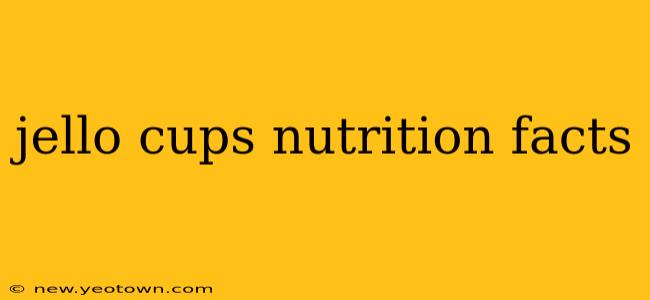Jell-O Cups: A Sweet Treat, But What's the Nutritional Scoop?
Ah, Jell-O cups. The jiggly, colorful dessert of childhood memories. But as we get older, and perhaps a little more health-conscious, we start to wonder: what's really in those little cups of wobbly goodness? This isn't just about calories; it's about understanding the ingredients and making informed choices about what we're feeding ourselves (and our kids).
Let's dive into the nutritional facts of Jell-O cups and address some common questions. Remember, the specific nutritional information can vary slightly depending on the flavor and size of the cup, so always check the label on the specific product you're consuming.
Understanding the Basics: What's in a Jell-O Cup?
The primary ingredients in most Jell-O cups are water, sugar, and gelatin. Gelatin is a protein derived from collagen, giving the Jell-O its characteristic texture. The sugar content is usually quite high, which is a significant factor in the overall nutritional profile. Depending on the flavor, artificial colors and flavors might also be added. Some varieties also contain added fruit pieces or other ingredients.
What are the calories in a Jell-O cup?
A typical small Jell-O cup (around 3.25 ounces) generally contains between 70 and 100 calories. This can vary by flavor and size. A larger cup or a variety with added ingredients will, of course, have more calories. Keep this in mind when considering your daily caloric intake.
How much sugar is in a Jell-O cup?
This is often a major concern. The sugar content in a single Jell-O cup typically ranges from 10 to 15 grams. Consider that the American Heart Association recommends a maximum of 25 grams of added sugar per day for women and 36 grams for men. A single Jell-O cup can quickly consume a significant portion of your recommended daily sugar intake.
Does Jell-O contain any protein or fat?
While gelatin provides a small amount of protein, the overall protein content is relatively low. Jell-O cups typically contain minimal fat. It's important to remember that Jell-O's primary nutritional contribution is sugar and minimal protein.
Are Jell-O cups a good source of vitamins and minerals?
No. Jell-O cups are not a significant source of vitamins and minerals. They are primarily a source of sugar and a small amount of protein. For essential vitamins and minerals, look to fruits, vegetables, and other whole foods.
What are the alternatives to Jell-O cups?
There are plenty of healthier alternatives to satisfy that sweet tooth. Consider making your own fruit-flavored gelatin using natural sweeteners like fruit juice or honey and adding real fruit pieces. You can also explore yogurt parfaits with berries and granola, fruit salads, or even a small piece of dark chocolate for a more nutrient-dense and satisfying treat.
Making Informed Choices
Jell-O cups can be an occasional treat, but they shouldn't be a staple in a balanced diet. The high sugar content should be kept in mind. By understanding the nutritional facts and being mindful of portion sizes, you can enjoy this nostalgic dessert in moderation. Always check the nutrition label on the specific product you are consuming to have the most accurate information.

